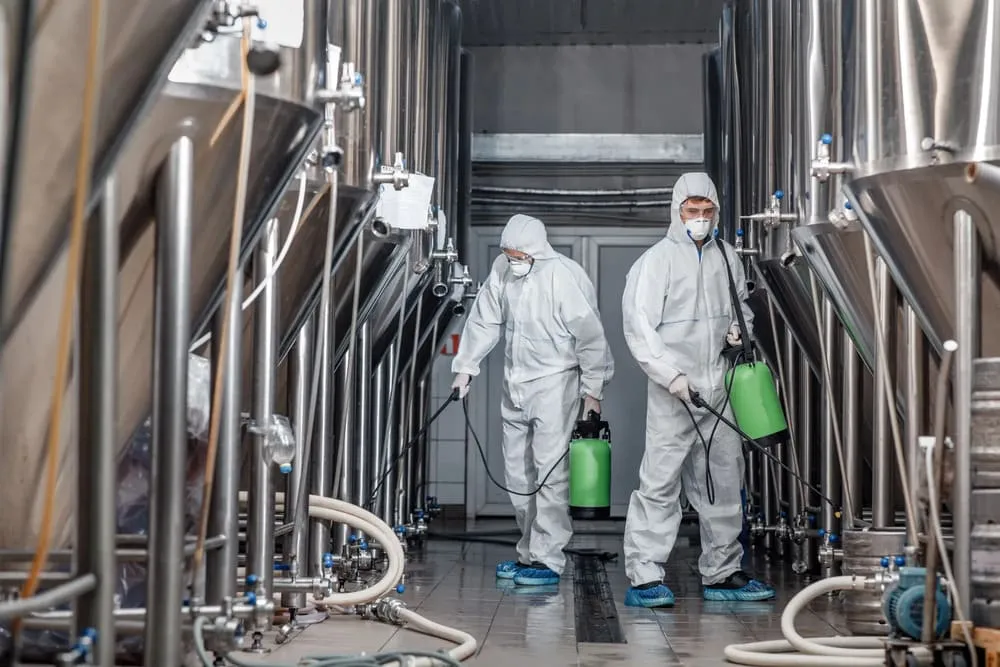Table of Contents
The disposable protective clothing market is expected to grow from USD 3.55 billion in 2020 to USD 5.84 billion by 2028, with a 5.9% CAGR(PR Newswire). This growth is driven by stricter safety regulations, industrial expansion, and rising demand for high-quality PPE. The COVID-19 pandemic further underscored the importance of disposable coveralls in infection control, boosting global demand significantly.
The material of choice for disposable coveralls is very important, considering protection levels and wearer comfort. This article explores key materials like polypropylene, SMS, PP+PE, microporous fabric, and Tyvek®, along with their features and ideal applications, to help you select the most suitable protective gear for your specific workplace needs.

What Are Disposable Coveralls Made Of ?
Disposable coveralls are essential personal protective equipment (PPE) that shield workers from various environmental hazards. The material selection is crucial, directly impacting protection levels, comfort, and suitability for specific work environments. Different materials offer unique characteristics, from basic protection to advanced resistance against liquids, chemicals, and particulates, making informed choices essential for workplace safety.

Polypropylene Coveralls
Polypropylene is the most affordable and commonly used material for disposable coveralls. It is lightweight and breathable, with limited protection against water and chemicals.
Polypropylene coveralls are ideal for applications that require minimal protection against hazardous materials, such as in hospitals, labs, food processing, and general industries. They are also suitable for cleanrooms due to low particle shedding, reducing contamination.

SMS Coveralls
Made of multiple layers combining spun bond and melt blown polypropylene, SMS coveralls ofter featured with breathable, high strength, tear-resistant, and offer excellent filtration.
SMS coveralls are commonly used in medical, pharmaceutical, and electronics industries where need both fluid and particulate resistance. They are also ideal for hot environments and emergencies due to breathability.

PP+PE Coveralls
PP+PE(polypropylene coated with PE film), is a mix of polypropylene and polyethylene for better liquid resistance. PP+PE enhances liquid resistance and is suitable for environments where exposure to liquids and chemicals.
PP+PE coveralls are more durable and strong than pure polypropylene, they can create a barrier against water and hazardous chemicals. So, they can be widely used in environments needing high resistance to liquids and chemicals, such as chemical plants, pharmaceutical industries, and food processing units.
Microporous Coveralls
Microporous fabric is a microporous film laminated onto a non-woven fabric, that allows air and water vapor to escape while preventing the penetration of liquids and solids.
Microporous coveralls are lightweight, and breathable, and offer high protection from liquids, chemicals, and particulates. As microporous fabric allows moisture to escape, making microporous coveralls very suitable for extended wear.
Microporous disposable coveralls are ideal choices for pharmaceutical manufacturing, nuclear facilities, cleanrooms, and hazardous material handling. During COVID-19, they are the most chosen protective clothing used in situations where there is a risk of contamination.

Tyvek Coveralls
Tyvek is a 100% synthetic material made from high-density spun bound polyethylene fibers, with strong protection. It is lightweight, tear-resistant, and offers an excellent barrier against water, chemicals, and harmful particulates. What’s more, Tyvek is usually more breathable than microporous fabric.
Known for comfort and reliable protection, Tyvek coveralls are the best choice for asbestos removal, chemical processing, painting, construction, and hazardous waste cleanup.
Choosing the Right Material for Disposable Coveralls

Consider these factors when selecting materials for disposable coveralls:
Work Environment
When selecting disposable coveralls, it’s essential to identify workplace hazards such as dry particles, asbestos, chemical splashes, or biological agents.
For example, for environments exposed to chemical splashes and hazardous particles, the most recommended disposable coveralls should be Type 4B/5B/6B coveralls, which are usually made of microporous nonwoven fabric.
Breathability and Comfort
Breathability and comfort can significantly affect the performance and safety of workers in coveralls.
| Material | Composition | Breathability |
|---|---|---|
| Polypropylene | A thermoplastic polymer. | Moderate |
| SMS | A tri-laminate fabric made of spun-bond polypropylene layers with a melt-blown filter. | High |
| PP+PE | A blend of polypropylene and polyethylene, combining properties of both materials. | Very low |
| Microporous | Composed of a microporous film over a spun-bond base layer. | Moderate to Low |
| Tyvek | Made from high-density polyethylene fibers compressed into a non-woven fabric. | High |
Of course, in addition to considering the breathability of the material, we can also address the breathability of Disposable coveralls in terms of design features and fit.
Protection Level Required
Determine the level of protection needed based on the task. Ensure the coveralls meet relevant safety standards and certifications for the industry. For example, EN 14126 for protection against infectious agents, then we should choose materials like microporous and Tyvek, which can protect against biological hazards.
By focusing on these factors, you can choose disposable coveralls that suit specific work conditions while ensuring safety and comfort.
Material Recommendations

Medical Settings
Choose microporous fabric, SMS, or Tyvek® materials for protection against biological hazards. Ensure compliance with standards like EN14126 for safety and breathability.
Industrial Cleaning:
Opt for microporous films or Tyvek® to block liquids and particulates. Look for elastic cuffs and breathable fabrics for comfort during extended tasks like chemical spills or painting.

Construction and Asbestos Removal:
Select Tyvek® or microporous fabric for a strong barrier against asbestos fibers. Ensure features like hoods, elastic cuffs, and boots, and verify compliance with Type 5 or equivalent standards for maximum safety.
Selecting the right material for disposable coveralls is essential for ensuring safety, comfort, and efficiency in various industries. Whether it’s polypropylene for basic protection, SMS for breathable durability, PP+PE for liquid resistance, or Tyvek® and microporous fabrics for advanced protection, understanding each material’s strengths is key. By considering workplace hazards, breathability, and required protection levels, you can choose coveralls that meet your needs while ensuring regulatory compliance.
Morntrip provides high-quality disposable coveralls tailored to your specific requirements. Contact us for expert guidance and free samples to ensure the best fit for your work environment.







